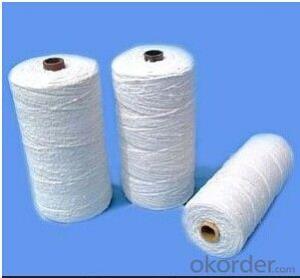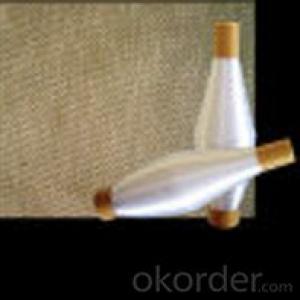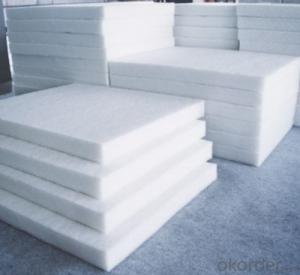Glass Fiber Textiles Thermal Insulation Ceramic Yarn Product
- Loading Port:
- Qingdao
- Payment Terms:
- TT OR LC
- Min Order Qty:
- 500 m
- Supply Capability:
- 2000 m/month
OKorder Service Pledge
OKorder Financial Service
You Might Also Like
Specifications
1. Ceramic fiber yarn.
2. Classfication Temp:1260C.
3. Low thermal conductivity.
Tech Data:
Colour | White | |||||
Al203+sio2% | >=97 | |||||
Fiber diameter(um) | 2-4 | |||||
Fiber Iength(mm) | 100-200 | |||||
Bulk density(Kg/m3) | 300-700 | |||||
Moisture % | <=1.0 | |||||
Thermal Conductivity(Hot face),w/m.k | 0.12~0.13(300°C) | |||||
Heating liner shringkage(%) | <=3.5(1000°C*3h) | |||||
High-temperature loss on lgnition | 10 | 15 | 20 | 15 | 20 | 25 |
Safe working temp°C | <=1000 | <=450 | ||||
Acid-resistance and alkali-resistance% | 50(10% NaoH After 72 hours) | |||||
Reinforced material | Stainless Steel | Glass filament | ||||
Application:
Ceramic fiber yarn used in producing ceramic fiber tape, ceramic fiber rope, ceramic fiber cloth and fabrics.
Used in high temperature sealing and insulation.
Hitex ceramic fiber yarn is made from alumina silica ceramic fiber, free of asbestos, can be used in different industrial applications under temperatures up to 2300 °F (1260 C) and has excellent chemical stability and strong resistance to thermal shock and corrosion attack. Exceptions are hydrofluoric and phosphoric acids and concentrated alkalis. It also resists oxidation and reduction,
- Q: Can glass fiber textiles be used in surgical implants?
- Surgical implants can indeed utilize glass fiber textiles. Glass fibers possess notable strength and biocompatibility, rendering them appropriate for diverse medical applications, such as surgical implants. They are commonly employed as reinforcement materials in composite implants, including bone plates, screws, and rods, to enhance both strength and stability. Glass fiber-reinforced composites have proven successful in orthopedic and dental implants, as well as in soft tissue repair. Moreover, these textiles serve as scaffolds in tissue engineering, facilitating cell growth and tissue regeneration. It is essential to recognize, however, that the biocompatibility of glass fiber textiles can vary depending on their composition and surface treatment. Consequently, thorough testing and evaluation are imperative to guarantee the safety and effectiveness of such textiles in surgical implants.
- Q: Are glass fiber textiles resistant to corrosion?
- Glass fiber textiles possess corrosion resistance. They are produced by spinning molten glass into delicate threads and weaving them into textiles. The glass fibers themselves are chemically inert and do not react with most chemicals or substances, providing a high level of resistance against corrosion. This corrosion resistance is further improved by the fact that glass fibers do not absorb moisture, preventing the growth of mold or mildew that could result in corrosion. Additionally, glass fiber textiles are also resistant to UV radiation, which can cause deterioration and corrosion in other materials. Consequently, glass fiber textiles are an outstanding option for applications requiring corrosion resistance, such as constructing chemical storage tanks, pipes, or other environments prone to corrosion.
- Q: Can glass fiber textile be used in pressure vessels?
- Yes, glass fiber textiles can be used in pressure vessels. They offer excellent strength-to-weight ratio, corrosion resistance, and high-temperature tolerance, making them suitable for various industrial applications, including pressure vessels.
- Q: Are glass fiber textiles resistant to UV rays?
- Generally, glass fiber textiles exhibit resistance to UV rays. This resistance stems from the excellent UV degradation resistance of glass fibers themselves, which is attributed to their inorganic nature. As a result, glass fiber textiles, being derived from these fibers, also possess this resistance. The sun's UV rays have the potential to cause damage to various materials over time, such as fading, weakening, and degradation. Nevertheless, glass fiber textiles are capable of enduring prolonged exposure to UV rays without significant deterioration, making them highly suitable for outdoor applications like awnings, canopies, and outdoor furniture. It should be noted that although glass fiber textiles are resistant to UV rays, they are not entirely impervious to the effects of extended exposure. Their performance may vary depending on the specific manufacturing process and any additional coatings or treatments applied to the textiles. Therefore, it is always advisable to adhere to the manufacturer's guidelines and implement proper care and maintenance measures to ensure the longevity of glass fiber textiles in outdoor settings.
- Q: Can glass fiber textiles be used in battery separators?
- Glass fiber textiles are capable of being utilized in battery separators. They possess distinct characteristics that render them appropriate for deployment in battery separators. Renowned for their impressive resistance to thermal factors, chemical inactivity, and outstanding electrical insulation attributes, these textiles are ideally suitable for battery separators. Their ability to endure the extreme temperatures and corrosive surroundings within batteries, coupled with their exceptional electrical insulation capabilities, effectively prevent short circuits. Furthermore, glass fiber textiles provide commendable mechanical strength and stability, which are crucial for upholding the structural integrity of battery separators. Ultimately, glass fiber textiles prove to be a dependable and efficient choice as materials for battery separators.
- Q: Are glass fiber textiles suitable for aerospace applications?
- Aerospace applications find glass fiber textiles to be suitable. These textiles, also known as fiberglass textiles, see extensive use in the aerospace industry for various purposes. They possess a commendable strength-to-weight ratio, high tensile strength, and good resistance to chemicals and heat. Composite materials in aerospace heavily rely on glass fiber textiles. These textiles frequently act as reinforcement materials in composite structures, such as carbon fiber composites. The combination of glass fiber textiles with other materials in composites enables the creation of lightweight yet strong components like aircraft wings, fuselage, and structural elements. Insulation materials in aerospace production also employ glass fiber textiles. Their exceptional thermal insulation properties render them appropriate for insulating spacecraft, satellites, and other aerospace vehicles. The textiles aid in maintaining stable internal temperatures, safeguarding sensitive equipment from extreme temperatures, and enhancing overall energy efficiency. Moreover, glass fiber textiles exhibit favorable electrical insulation properties, a critical aspect in aerospace applications. They can be utilized to fabricate protective covers for wiring and electrical components in aerospace vehicles, ensuring electrical safety and preventing interference. Apart from their physical properties, glass fiber textiles are relatively easy to manufacture, cost-effective, and readily available. These characteristics make them the preferred choice for aerospace applications, where reliability, performance, and cost-efficiency hold great significance. All in all, glass fiber textiles prove to be well-suited for aerospace applications due to their strength, lightweight nature, thermal insulation properties, electrical insulation capabilities, and cost-effectiveness. Their usage in composite materials and insulation systems contributes to the development of safer, more efficient, and technologically advanced aerospace vehicles.
- Q: How do glass fiber textiles resist staining?
- Glass fiber textiles resist staining due to their unique properties and manufacturing process. These textiles are made from tiny strands of glass that are woven together to form a strong and durable fabric. The glass fibers are inherently resistant to many substances that typically cause staining, such as oils, chemicals, and liquids. Glass fiber textiles have a non-porous surface, which means that stains cannot penetrate the fabric easily. This makes them less prone to absorbing and retaining dirt, dust, and other substances that can cause staining. Instead, stains tend to sit on the surface of the fabric, making them easier to clean and remove. Additionally, glass fiber textiles are often treated with special coatings or finishes that enhance their stain resistance. These treatments can provide an extra layer of protection against stains and make the fabric more resistant to dirt and grime. These coatings can also make the fabric easier to clean, as they can prevent stains from setting in and becoming more difficult to remove. Furthermore, glass fiber textiles are generally more resistant to fading and discoloration caused by exposure to sunlight or harsh chemicals. This is because the glass fibers are not affected by UV rays or chemical reactions in the same way that other materials, such as natural fibers, are. As a result, glass fiber textiles can maintain their original color and appearance for longer periods, reducing the likelihood of staining or discoloration. Overall, the unique composition, non-porous surface, and special treatments of glass fiber textiles contribute to their resistance to staining. These properties make them an excellent choice for applications where stain resistance is important, such as in upholstery, carpets, and other textile products.
- Q: Is glass fiber textile hypoallergenic?
- Glass fiber textiles are generally considered hypoallergenic. Unlike natural fibers such as wool or cotton, glass fibers do not contain any organic matter that can trigger allergic reactions. They are also resistant to mold, mildew, and other allergens, making them a suitable choice for individuals with allergies or sensitivities. Additionally, glass fiber textiles are typically non-toxic and do not release any harmful particles or chemicals into the air, further reducing the risk of allergic reactions. However, it is important to note that individual sensitivities can vary, and some people may still experience mild irritation or discomfort when in contact with glass fiber textiles.
- Q: Can glass fiber textile be used in tents and awnings?
- Certainly! Tents and awnings can indeed utilize glass fiber textile. This material, being both lightweight and durable, possesses exceptional strength and resilience against severe weather conditions. Moreover, it displays resistance to UV rays, rendering it ideal for outdoor purposes. Often employed as reinforcement in tent and awning construction, glass fiber textiles enhance stability and structural integrity, enabling these shelters to withstand strong winds and heavy rain. In addition, they are effortless to clean and maintain, boasting a lengthy lifespan, which accounts for their popularity in outdoor shelters.
- Q: What are the different cutting methods for glass fiber textile?
- Some of the different cutting methods for glass fiber textile include using a sharp blade or scissors for manual cutting, using laser or waterjet cutting machines for precision cutting, and using automated cutting equipment for large-scale production.
Send your message to us
Glass Fiber Textiles Thermal Insulation Ceramic Yarn Product
- Loading Port:
- Qingdao
- Payment Terms:
- TT OR LC
- Min Order Qty:
- 500 m
- Supply Capability:
- 2000 m/month
OKorder Service Pledge
OKorder Financial Service
Similar products
Hot products
Hot Searches
Related keywords
























